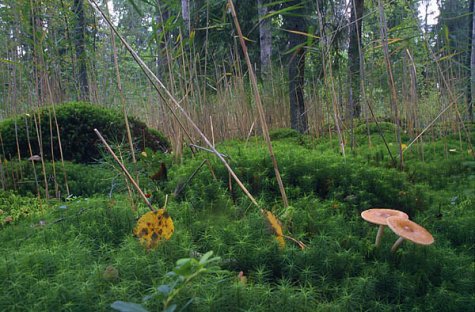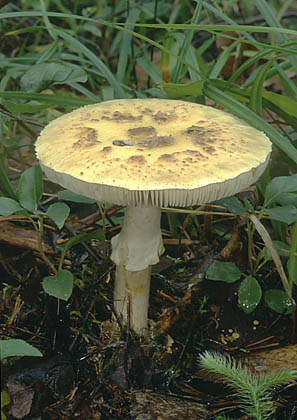How should fungi be protected?
Photos: Arne Ader
Interview: Helen Arusoo
Translation: Liis
Paludified forest at Salupeaksi, Nigula bog area.
The Mushroom week promises to bring beautiful early autumn weather.
Star events at the Rõuge Mushroom Week on September 7.-13. are the opening of the mushroom exhibition on Tuesday and academician Erast Parmasto’s lecture „Protecting mushrooms: why and how”. So tomorrow we will be going to listen to the Mushroom Master. Before the evening lecture there is a mushroom excursion for all, with mycologists Vello Liiv and Mall Vaasma as guides.
Bring your mushroom basket and some bread and butter.
The bus leaves from the National Library on Tuesday morning at 8.00, back in Tallinn at 23.45.
Excursion and bus fee for adults - students and pensioners included - 200 Krooni, schoolchildren 150 Krooni, children under school age free.
Info and registering 6 481 740, 56476297 or info@looduseomnibuss.ee
Erast Parmasto, you will talk at the Rõuge mushroom week about “Protecting fungi: Why and how?” – why the word „why” in the title? Isn’t it obvious that endangered species should be protected ...?
If this had always been clear to us, the protection measures for the first fungi wouldn’t have started 56 years later than protecting plants in Estonia. And not only endangered species should be protected: just look how many kicked-over, crushed, trampled non-edible mushrooms there are in Estonia’s mushroom forests. The same in city parks. And if it were clear, the protection legislation for some extremely rare species, in a European or global perspective, would already be set up.
How did the first fungi come to be protected? Who were the initiators?
Well, we simply pushed ourselves into the group that compiled the third listing for the Estonian Red Book, and the group that were to set up the 1994 list of protected species. Using some force. Not as single individuals, but all together (the Mycology section of ELUS, the Estonian Mycologists Society, simply a gang of mycology experts). Actually, we didn’t really meet any opposition, we were rather praised for pointing out that mushrooms too were living organisms.
How many fungus conservation areas are there in Estonia at the moment?
From 2007 we have the Liiva-Putla nature reserve area on Saaremaa, where the main reason for establishing it was the great number of rare and protected fungus species. Many other protected areas are important for the conservation of mushrooms besides the other objectives – for instance the Järvselja primeval forest, the Kurisoo nature reserve area, several zones in the Nigula and Alam-Pedja Nature reserve areas. In addition a number of the habitats of protected species have been protected as smaller so called habitat protection areas.
Erast Parmasto will talk more about protecting fungi at the Rõuge Mushroom Week on Tuesday Spetember 8, at 17.00
Erast Parmasto: ”Protection of fungi in Estonia was realised 56 years after the protection of plants”.
Death cap (Amanita phalloides).










